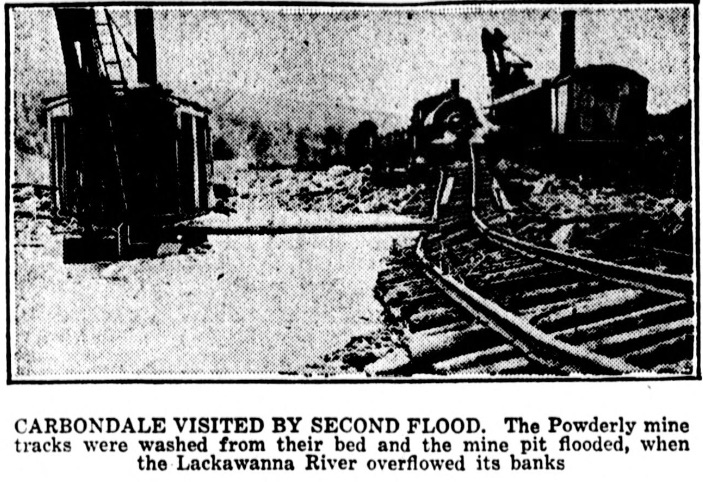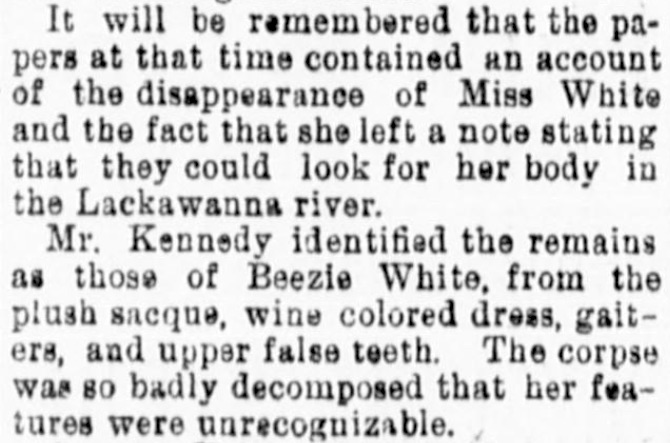
Lackawanna was my third grade, extra credit spelling word, but little did my teacher know that the Lackawanna River had quite a history.

River on Fire
A train wrecked and twelve railcars were tossed into the river near Peckville in 1892. Two of those cars were oil tanks and, shortly after the crash, the river burst into flames.
Several men were arrested after the wreck. Apparently, they were responsible for setting the floating oil on fire and putting a number of homes along the river in danger of being burnt down. [1]
Three Months in the River
The Scranton Tribune reported in 1894 that the body of Richard Caffrey had finally been found after having fallen into the Lackawanna River three months previous.
According to the article, “On the morning of March 7, Caffrey fell over the retaining wall, near Gas House Bridge, into the water, and was carried down stream until the body found lodgment against a water main.”
On June 12, the body was found in the middle of the river under the Elm Street Bridge. Three painters who were working on the bridge spotted what they thought was the bloated corpse of a dog. The smell was unbelievable and the men decided to go under the bridge to try and dislodge the remains so that it would float further down the river. However, as they examined the corpse more closely, they realized that it was the body of a person and not a dog:
“The trunk of it was without any clothing and had reached that stage of decay where the flesh was the color of brown wrapping paper. The flesh was gone from the head leaving the ghastly white skull and the upper vertebrae of the spinal column exposed. The arms and legs were eaten away, nothing but the bones remaining. The trousers that the dead man wore were turned inside out and attached by shreds to the bones of the feet.” [2]
Knocked Off the Bridge
In the late 1800s and early 1900s, there were a great number of deaths that happened because people would walk across the train bridges.
This was the case back in 1896 when a grandmother and her two grandchildren were tragically knocked off a train bridge and into the Lackawanna River:
“The woman picked the younger child up in her arms and was carrying her across the bridge, leading the other one by the hand. They had reached the middle of the bridge when an engine and tender came along behind them. The noise at once attracted her attention. Realizing her peril she made a heroic effort to grab up the other child and step to one side of the way, but there is no room on the bridge to get out of the way in an emergency of this kind, and the engine struck her and sent her down into the river carrying the two children along.” [3]

Trout Fishing
Long before the mines began polluting the river, people remembered a time when the Lackawanna River was famous for its trout fishing. This was back in 1898 when people were realizing that the water from the mines being pumped into the river was killing off all the fish.
Above the mines, however, there were still fish to be caught, but no trout.
In spite of the knowledge that the mine water was killing off wildlife, there was nothing to stop the mines from continuing to poison the waters. After all, the mines were huge money makers and money often trumps the needs of the environment. [4]
Raw Sewage
“Danger Lurks in Polluted Steams” was the headline in The Scranton Tribune back in 1900. Apparently, the streams draining into the Lackawanna River were full of raw sewage from hundreds of homes and one of the streams passed through a cemetery where almost 15,000 bodies were interred.
The only solution talked about at that time was about changing the course of one of the streams so that it avoided the cemetery. Other than that, the health board reported that in July 1900 there were “65 cases of contagious disease reported, 24 diphtheria and 31 scarlet fever.” [5]
Footbridge Collapse
In 1904, a temporary footbridge was built over the Lackawanna River in Scranton, PA. However, as people began using it to get to a local circus, the bridge collapsed. Forty people were sent into the water. Fortunately, none of them drowned and they were all safely rescued. [6]

Severe Drought in 1907
Back in 1907, a newspaper published in Bloomsburg, PA claimed that “if it wasn’t for the water that is pumped from the mines and drained into the bed of the stream there wouldn’t be any Lackawanna River.”
The river’s water was so depleted at that time that people were okay with the mines pumping poisonous water into the river. The fish were long gone so the polution did not matter. [7]
The Sudden Cloudburst of 1914
In July, 1914, a fast moving, violent storm opened up over Scranton, PA. As the rain poured down, lightning struck a school, a church, and numerous houses. Hundreds of homes in the lower parts of the city were flooded.
North of the city, in Archbald, 25 men were 200 feet deep into a mine. A dam had burst, the creek overflowed, and the water found its way into the mine. The men had to work their way out of the mine and pushed through water that was up to their shoulders.
A total of four lives were lost to the fierce storm. Three lives were lost in the Lackawanna River and one young boy fell into an old mine cave hole and drowned. [8]

